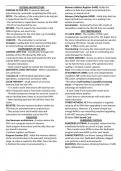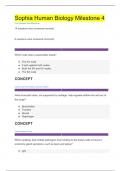SYSTEMS ARCHITECTURE Memory Address Register (MAR) -Holds the
PURPOSE OF THE CPU: To process data and address of data that needs to be fetched from
instructions by constantly completing the FDE cycle memory or stored into it.
FETCH: -The address of the instruction to be fetched Memory Data Register (MDR) - Holds data that has
is copied from the PC to the MAR been fetched from memory or is waiting to be
-The instruction is copied from memory to the MDR written to memory.
-The PC is incremented by one Accumulator - Temporarily stores the results of
DECODE: -The CU inspects the instruction in the calculations made by the ALU till they are needed.
MDR & figures out what to do CPU PERFORMANCE
-The CU prepares for the next step: e.g. by loading 1) CLOCK SPEED: -The number of FDE cycles
values into the MAR/MDR completed per second by the CPU. The higher this is
EXECUTE: - The instruction is carried out. the more instructions can be processed per second,
Examples: Loading data from memory/writing data increasing CPU faster. Usually around 3.5GHz.
to memory/doing calculations using the ALU GHz - 1 billion cycles per second
COMPONENTS OF THE CPU: Overclocking: Increasing the clock speed over the
CONTROL UNIT (CU) - Coordinates/manages the recommended rate - can lead to overheating and
activities of the CPU during the FDE cycle could damage the machine
-Controls the flow of data both inside the CPU and 2) CACHE MEMORY: -Access to cache is much faster
outside (RAM, Input/output) than RAM. The more cache there is the more data
- decodes instructions can be held for fast access. CPU spends less time
- Sends control signals to execute the instructions waiting. L1-Fastest, lowest capacity,
ARITHMETIC LOGIC UNIT (ALU) - Where calculations Issue: It is costly so most comps have small amount
are carried out 3) NUMBER OF CORES: Each core independently
-Includes (4): mathematical operations, logic completes FDE cycles thus more cores means more
operations, comparisons and binary shifts FDE cycles completed simultaneously.
CACHE MEMORY - Small amount of very fast -This allows multi-tasking & parallel processing
memory built into the CPU. Issues: - Programs have to be written to take
- It is used to store instructions OR data that are advantage of multiple cores.
either frequently used or have been recently used. - It won’t help if one instruction needs to be
- Provides temporary storage for very fast access to processed before another
reduce fetching time; faster to access than RAM. - Cores have to communicate with each other
- When fetching data the CPU will first check the which takes time
Cache. OTHER METHODS: 4) If the computer is regularly
REGISTER -Discrete memory locations within the using up all its RAM then upgrading it may improve
CPU that are extremely fast to read/write to performance. However, if a system already has
- They accept store and transfer data and enough RAM to run everything required upgrading
instructions for immediate use by the CPU. it will NOT increase performance.
REGISTERS 5) Better GPU/Sound Card
Von Neumann architecture: A system where the EMBEDDED SYSTEMS
CPU runs a program stored in memory. EMBEDDED SYSTEMS: A computer system that has
-Both program instructions and the data they use a dedicated function as part of a larger system
are stored in memory - They contain some ROM to store the dedicated
-Contains registers and buses program and some RAM to store user inputs
Program Counter (PC) - Holds the memory address CHARACTERISTICS: Low Power (energy efficient),
of the next instruction to be executed. During fetch small size, low cost, Dedicated Software, Rugged
stage, its value is copied to the MAR. Once the data (can perform in harsh environments)
is fetched, the value is incremented by 1. EXAMPLES: Microwaves, Washing Machines, Traffic
lights, dishwashers
, MEMORY & STORAGE P: Huge Capacity, Cheap, reliable
PRIMARY STORAGE N: Less Portable, moving-parts (slower access
PRIMARY STORAGE NEED: CPU can access and speed, vulnerable to shock can break [fragile]), large
read/write from it very quickly. They are needed as physical size
secondary storage is much slower Suitable: Backup systems, fixed position PC’s
VOLATILE: Power is required for the component to 3) Solid-State Storage: Memory sticks, SD card, SSD
retain data P: No moving parts (Very fast), portable, shock
NON-VOLATILE: The component retains data even resistant (durable), no noise, power-efficient, no
when the power is turned off need to defragment, small physical size
RAM: - Volatile, Can be read from and written to N: Expensive, limited number of read/write cycles
- Where all instructions, program and data are Suitable: Portable devices: smart phones, cameras,
stored while they are being used memory sticks
- Larger than ROM CHARACTERISTICS
- Stores the part of the OS currently being used CAPACITY: Maximum amount of data that can be
ROM: Non-Volatile, Read-Only, cannot be written to stored on it
- Used to store the BIOS & in embedded systems PORTABILITY: How easy it is to carry around
- Small amount of memory ACCESS SPEED: How fast data can be read/edited
BIOS: Loads the OS to take over managing COST: average price it costs
computer, Performs self-diagnostic checks on the RELIABILITY: likelihood of the device continuing to
hardware and produces an error message/code if perform well over time
errors are found DURABILITY: Strength of a device, to last without
NEED FOR VIRTUAL MEMORY: When there is not breaking
enough space in RAM for all the programs and data UNITS
currently in use, so some secondary storage is used Data must be stored in binary format as it
-Occurs due to too many apps/memory-intensive represents on (1) or off (0) switch.
apps 1 Bit = 1 Binary Digit
HOW IT WORKS: Programs not currently being Nibble = 4 Bits
executed are transferred out of RAM to the (B) Byte = 8 Bits / 2 Nibbles
Secondary Storage. They are swapped back in to (KB) Kilobyte = 1000 B
RAM when they are needed. (MB) Megabyte = 1000 KB
- The swapping is done by the OS. (GB) Gigabyte = 1000 MB
ISSUES: Disk-Thrashing: When a computers (TB) Terabyte = 1000 GB
performance becomes very slow due to excessive (PB) Petabyte = 1000 TB
use of SS; Secondary storage is slower to access; - Add 10% to include Metadata
Constant use of Secondary Storage can use up its FILE SIZE CALCULATIONS:
read/write cycles, reducing its lifespan. SOUND (3): Sample rate x duration (s) x bit depth
> Thus it is more preferable to upgrade RAM IMAGE (3): colour depth x image height (px) x image
SECONDARY STORAGE width (px)
NEED: Secondary storage is non-volatile, thus TEXT (2): Bits per character x number of characters
provides long-term storage. Without this all data (including spaces)
would be lost when the computer is turned off LEFT SHIFT - Multiplies by 2. If this removes a 1 then
TYPES: an overflow error occurs
1) Optical storage: DVD, CD, BLU-RAY RIGHT SHIFT - Divides by 2
P: Cheap, light weight > portable If any of these remove a digit than the number
N: Prone to scratches > not durable, slow access ‘loses precision/accuracy’
speed, low capacity Overflow errors: When a binary number is too large
Suitable: Mass-produced games/videos to be stored in the bits available
- Blu-ray gives the highest capacity Most significant bit (MSB): The leftmost bit which
2) Magnetic: HDD, Floppy Disk has the highest value
, Least significant bit (LSB): The rightmost bit which Sample rate: how many samples made per second
has the lowest value (Hz). QUALITY
CHARACTERS Duration: The numbers of seconds in a sound file
CHARACTER SETS: A defined list of characters with (s).
their equivalent unique binary number recognised Bit Depth: The number of bits used to store each
by the computer hardware & software. sample. QUALITY
-All computers need an agreed character set to be HOW IT’S DONE:
able to send and receive data correctly -The amplitude of the sound wave is measured at
-The number of characters that can be stored in a specific, constant intervals and converted to be
set is proportional to the number of bytes being stored as binary. This is done by the ADC (Analogue
used. FORMULA: 2n n = no. of characters to digital converter).
ASCII (American Standard Code for Information Increase sample rate:
Interchange): Contains all main English characters, -Increases quality
(uppercase and lower case), numbers (0-9). -Increases file size
Punctuation, symbols, space & non-printable Increasing bit depth:
control codes -Increases quality
- 7 bit > 27 = 128 possible characters. An extra 0 is -Increases file size
placed at the start to convert it to its Unicode Increasing duration
equivalent -Increases file size
-The code is logically ordered COMPRESSION
EXTENDED ASCII - One more bit was added to make NEED FOR COMPRESSION: To make larger file sizes
8 bit numbers. This means 256 values can be stored. smaller as storage on device is limited.
The extra values were used for: mathematical - Decrease storage space the file uses
operators, some other language characters - Speeds up file transfers
-This still didn’t represent all the characters needed - Streaming/downloading takes less bandwidth
UNICODE: 16 bit. 216 = 65, 236 combinations. LOSSY COMPRESSION: Compression where some of
-Original ASCII/Extended ASCII are still the same in the data is permanently lost. Only for images, sound
Unicode. & video
-Now there is extra space for more language P: Greatly reduces file size, visual quality is not
characters and emojis . really affected, no need to decompress
IMAGES N: Not for text based files, reduces quality, file can’t
-An image is represented as pixels. Each pixel has a be turned back into the original
specific colour represented as binary numbers LOSSLESS COMPRESSION: Reduces file size in such a
METADATA: Additional information about the way that no data is lost and the original file can be
image such as how to rebuild it. regenerated exactly
Examples: Width, height, date created, location P: Can be used on all types of data, can be turned
TOTAL NUMBER OF COLOURS = 2n n = colour depth back to original format, No reduction in quality
COLOUR DEPTH: The number of binary digits used N: Usually less effective, must be decompressed
to represent each colour. The more combinations of
colour that can be used the higher quality image
-Increases quality & file size
RESOLUTION: The number of pixels in an image.
More pixels will make the edges appear smoother
and give a more accurate representation of the
image.
-Increases quality & file size
SOUND
Sample: One recording of the amplitude.





